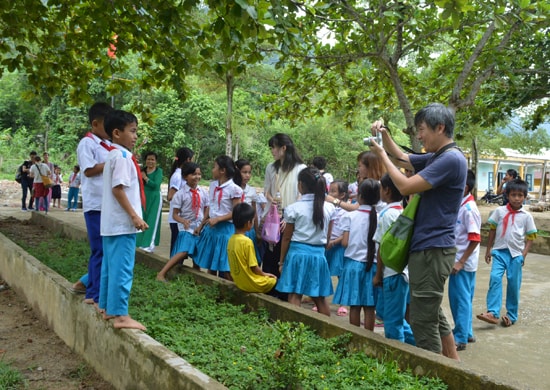(QNO) - The local residents’ income has been improved and the traditional cultural values have been conserved in Ta Bhing (Nam Giang district, Quang Nam province) by Co Tu community-based tourism.
 |
| A Japanese tourist in a school in Ta Bhing. |
Raising the pride
The Co Tu community-based tourism project in Ta Bhing commune deployed in April 2012 was supported by the Foundation for International Development Relief (FIDR). This project aims to better the local residents’ income, conserve and prove local resources and traditional culture. Until September 2015, Ta Bhing received 13 tourist delegations with the turnover of 130 millions VND.
There have been 65 delegations to Ta Bhing since this project started. One day in Ta Bhing, tourists can experience Co Tu community’s cultural activities such as: Tang tung and Dada dance, traditional food, brocade cataract weaving in Zara village…According to Mr Briu Thuong- leader of tourism group of the Management Board of Co Tu community-based tourism project, although the turnover of tourism here is not high, the success of this project is to raise the local residents’ pride of the Co Tu community’s cultural values, especially in younger generation.
Mrs Nguyen Thi Kim Lan, lead of weaving group in Zara (Ta Bhing) said that tourism can revive the craft village, give jobs to the locals, especially women. In 2014, the village’s brocade brought over 160 million VND to her village. Only in 9 first months of this year, this number was over 90 million VND.
Building the initiative in community
According to Pham Thi Nhu, Vice Chairwoman of Nam Giang district’s People Committee, the project is a big success, especially in local cultural conservation and community’s activities. We now only receive one-day tours with at least 6 tourists to keep the villagers’ peaceful life, minimize the outside impacts into the local culture and life.
Ms Nobuko Otsuki- Chief representative of the FIDR in Vietnam said: “The effect of this tourism model on this community is rather clear in many fields of economy, culture and society. Especially, the connection of culture over generations and the inheritance of village tradition will build the community’s future with the positive participation of women. This brings the social justice.
By THAN VINH LOC